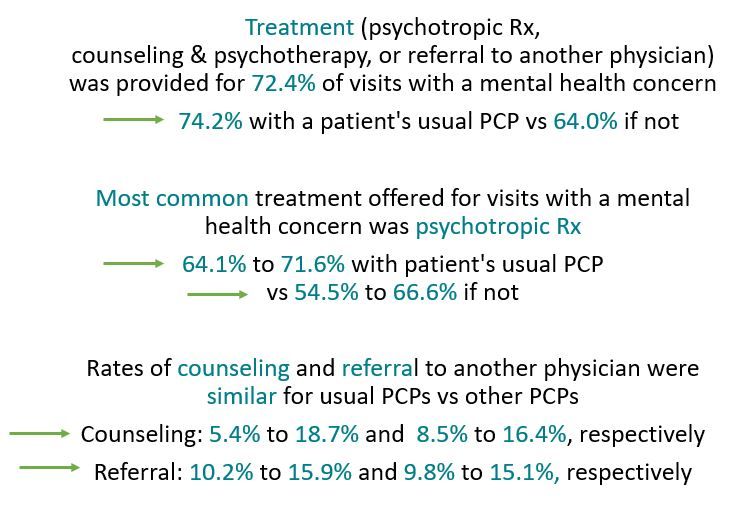- Clinical Technology
- Adult Immunization
- Hepatology
- Pediatric Immunization
- Screening
- Psychiatry
- Allergy
- Women's Health
- Cardiology
- Pediatrics
- Dermatology
- Endocrinology
- Pain Management
- Gastroenterology
- Infectious Disease
- Obesity Medicine
- Rheumatology
- Nephrology
- Neurology
- Pulmonology
Use of Primary Care Visits for Mental Health Concerns Rising Steadily, Study Finds
©WavebreakMediaMicro/Adobe Stock

The proportion of US outpatient primary care visits that addressed mental health concerns increased by nearly 50% between 2006 and 2018, representing 15.9% of all visits by 2016 and 2018, according to study findings published in the February issue of Health Affairs.
The study also found shifts in the types of mental health conditions addressed in primary care during the study period, racial and ethnic differences in use of primary care for mental health concerns, and that the likelihood of a mental health issue being discussed was higher when patients visited their usual primary care physician (PCP) than another clinician.
The study, by researchers from Brigham and Women’s Hospital in Boston, assessed the impact of changes in the delivery of mental health services on primary care use and capacity. Led by Lisa S. Rotenstein, MD, MBA, assistant professor at Harvard Medical School, the research team analyzed cross sectional data from the 2006-2018 National Ambulatory Medical Care surveys on 109 898 visits to primary care physicians among adults aged ≥18 years.
In addition to temporal trends in addressing mental health, Rotenstein et al also were interested in the characteristics of patients and visits that were associated with a greater likelihood of a mental health discussion, the specific mental health issues seen, and whether and what type of treatment was provided.
FINDINGS
Increase in diagnosis. They found that the proportion of visits that had a mental health concern as its primary diagnosis grew from 3.4% in 2006-2007 to 6.3% in 2016-2018 (P <.001). During the same period, the proportion of visits that addressed any kind of mental health concern went from 10.7% to 15.9% (P <.001), an increase of nearly 50%. That compares to an 18.6% increase in the prevalence of any mental health illness among American adults during the approximate same period.
Regular care provider. By a margin of 11.2% to 8.9% (P <.001), patients were more likely to have mental health concerns addressed in a visit with their usual PCP than a visit with one who was not their usual primary care provider. This increased to 16.8 percent for the usual PCP in 2016 and 2018 versus 12.4 percent if not (P <.001).
Shifts in type of disorder. Rotenstein and colleagues found that the type of mental health concern being addressed in primary care visits changed during the study period. The percentage of anxiety and stress-related diagnoses, the most common of those identified, increased from 29.4% in 2008-2009 to 34.5% in 2016 and 2018, with a peak of 38% in 2014-2015.
On the other hand, the proportion of visits addressing depression and affective disorders dropped from 32.4% (2006-2007) to 20.8% (2016-2018) as did rates of serious mental illness from 5.4% to 3%. Disorders related to use of psychoactive substances rose from 10.3% in 2006–2007 to 15.4% in 2016 and 2018.

Racial/ethnic differences. The study also found significant race and ethnicity-based differences in the use of primary care visits for mental health reasons. Specifically, Black and Hispanic patients were each 40% less likely than white and non-Hispanic patients to have a mental health concern addressed during a visit. The authors call for additional study to better understand the process disparities and structural and communication barriers that contribute to less common treatment of mental health conditions in primary care for these populations.
Increased odds. In adjusted analyses, younger age, payment via Medicare or Medicaid, female sex, and the visit physician being the patient’s usual PCP were all associated with significantly greater odds of a mental health concern being addressed in the visit. Other than a significant increase observed in prevalence of a mental health diagnosis among patients aged 18 to 44 over the study period, the analysis revealed no significant interactions between time and other demographic factors.
The authors cite two reasons for the growth of primary care clinicians treating mental health issues: the ongoing shortage of mental health specialists, and the growing embrace of the patient-centered medical home concept, which includes greater integration of behavioral health into primary care. Their findings, they say, underscore the need to provide PCPs with the tools to address patients’ mental health needs such as co-located therapy or psychiatry providers, longer visit lengths, and billing codes and documentation systems that make it easier to address both mental and physical needs.
Moreover, the fact that patients are more likely to get mental health counseling from their usual primary care physician than with another provider builds on “previous work demonstrating the importance of having an ongoing supportive relationship with a usual primary care doctor for addressing the full continuum of patient needs, and mental health needs in particular.”
Reference: Rotenstein LS, Edwards, ST, Landon BE. Adult primary care physician visits increasingly address mental health concerns. Health Affairs. 2023;42:163-171. doi: 10.1377/hlthaff.2022.00705
